Hospitality Operations Report
VerifiedAdded on 2020/12/18
|11
|3252
|421
Report
AI Summary
This report analyzes the role of menu engineering and food & beverage management in the hospitality industry, using The Lanesborough hotel in London as a case study. It examines the history of menus, the responsibilities of food & beverage managers, and the factors influencing menu engineering. The report also discusses the challenges of implementing strategies for healthier menu options, considering nutritional concerns in purchasing and storage.
Contribute Materials
Your contribution can guide someone’s learning journey. Share your
documents today.

Hospitality
Operations
Operations
Secure Best Marks with AI Grader
Need help grading? Try our AI Grader for instant feedback on your assignments.
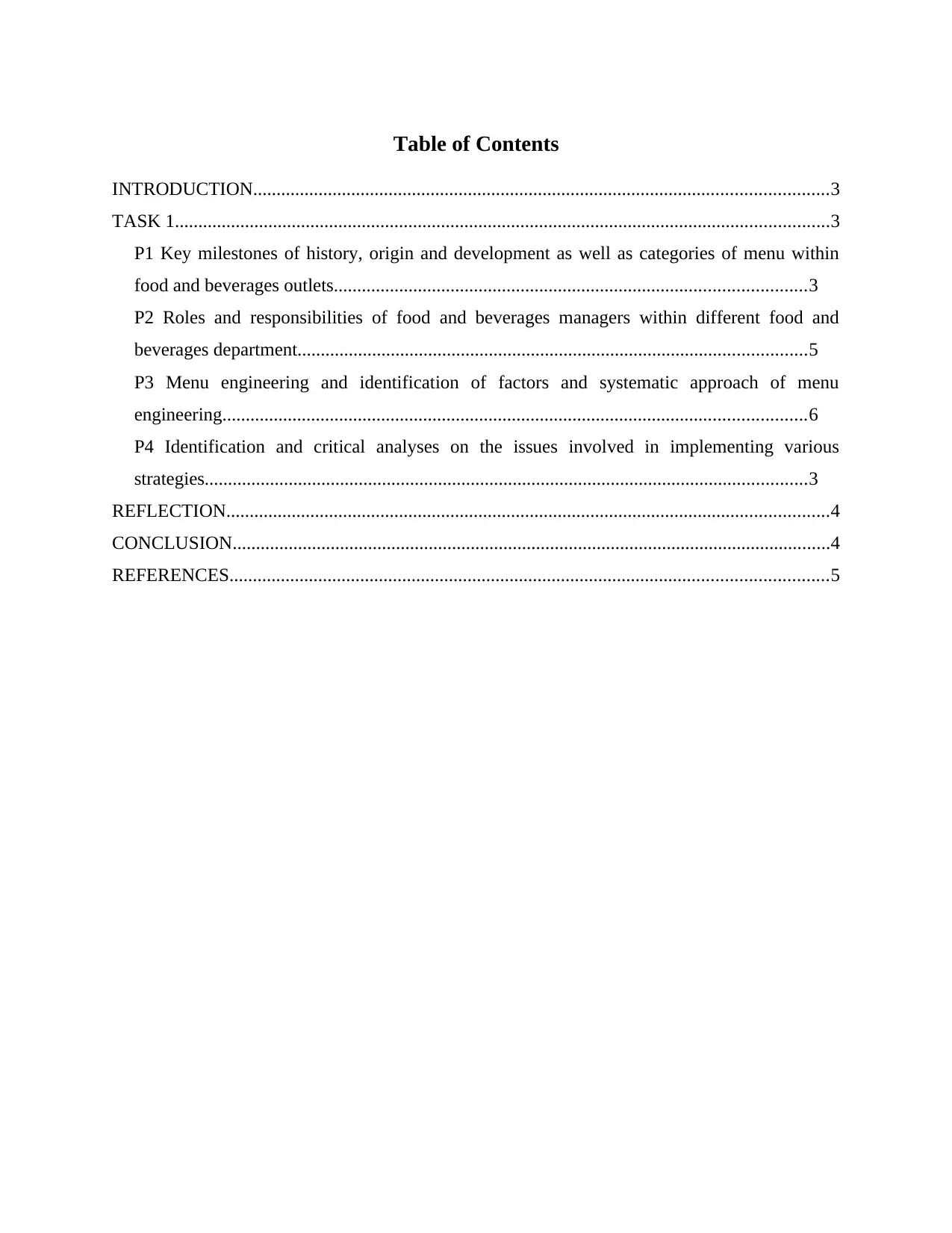
Table of Contents
INTRODUCTION...........................................................................................................................3
TASK 1............................................................................................................................................3
P1 Key milestones of history, origin and development as well as categories of menu within
food and beverages outlets.....................................................................................................3
P2 Roles and responsibilities of food and beverages managers within different food and
beverages department.............................................................................................................5
P3 Menu engineering and identification of factors and systematic approach of menu
engineering.............................................................................................................................6
P4 Identification and critical analyses on the issues involved in implementing various
strategies.................................................................................................................................3
REFLECTION.................................................................................................................................4
CONCLUSION................................................................................................................................4
REFERENCES................................................................................................................................5
INTRODUCTION...........................................................................................................................3
TASK 1............................................................................................................................................3
P1 Key milestones of history, origin and development as well as categories of menu within
food and beverages outlets.....................................................................................................3
P2 Roles and responsibilities of food and beverages managers within different food and
beverages department.............................................................................................................5
P3 Menu engineering and identification of factors and systematic approach of menu
engineering.............................................................................................................................6
P4 Identification and critical analyses on the issues involved in implementing various
strategies.................................................................................................................................3
REFLECTION.................................................................................................................................4
CONCLUSION................................................................................................................................4
REFERENCES................................................................................................................................5
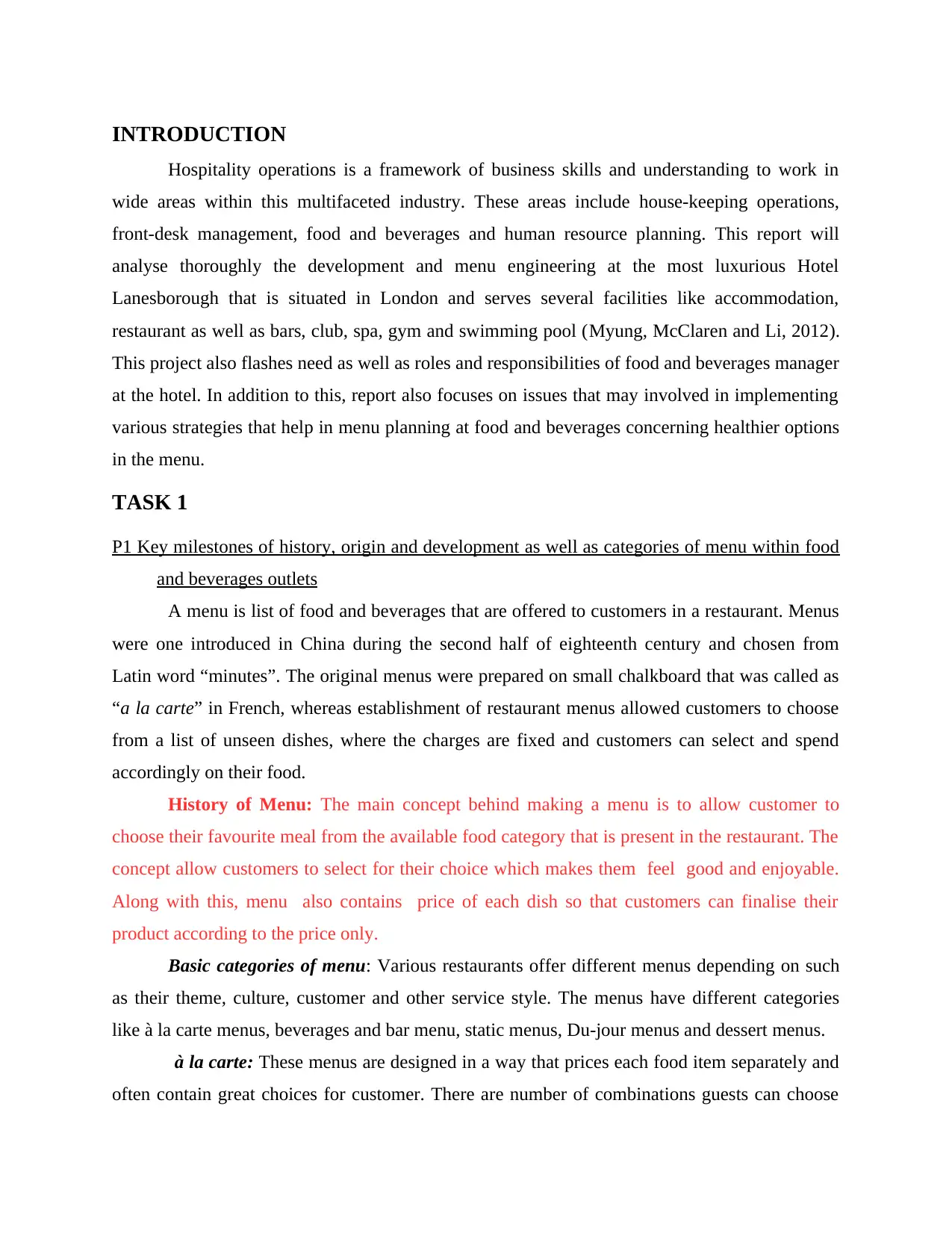
INTRODUCTION
Hospitality operations is a framework of business skills and understanding to work in
wide areas within this multifaceted industry. These areas include house-keeping operations,
front-desk management, food and beverages and human resource planning. This report will
analyse thoroughly the development and menu engineering at the most luxurious Hotel
Lanesborough that is situated in London and serves several facilities like accommodation,
restaurant as well as bars, club, spa, gym and swimming pool (Myung, McClaren and Li, 2012).
This project also flashes need as well as roles and responsibilities of food and beverages manager
at the hotel. In addition to this, report also focuses on issues that may involved in implementing
various strategies that help in menu planning at food and beverages concerning healthier options
in the menu.
TASK 1
P1 Key milestones of history, origin and development as well as categories of menu within food
and beverages outlets
A menu is list of food and beverages that are offered to customers in a restaurant. Menus
were one introduced in China during the second half of eighteenth century and chosen from
Latin word “minutes”. The original menus were prepared on small chalkboard that was called as
“a la carte” in French, whereas establishment of restaurant menus allowed customers to choose
from a list of unseen dishes, where the charges are fixed and customers can select and spend
accordingly on their food.
History of Menu: The main concept behind making a menu is to allow customer to
choose their favourite meal from the available food category that is present in the restaurant. The
concept allow customers to select for their choice which makes them feel good and enjoyable.
Along with this, menu also contains price of each dish so that customers can finalise their
product according to the price only.
Basic categories of menu: Various restaurants offer different menus depending on such
as their theme, culture, customer and other service style. The menus have different categories
like à la carte menus, beverages and bar menu, static menus, Du-jour menus and dessert menus.
à la carte: These menus are designed in a way that prices each food item separately and
often contain great choices for customer. There are number of combinations guests can choose
Hospitality operations is a framework of business skills and understanding to work in
wide areas within this multifaceted industry. These areas include house-keeping operations,
front-desk management, food and beverages and human resource planning. This report will
analyse thoroughly the development and menu engineering at the most luxurious Hotel
Lanesborough that is situated in London and serves several facilities like accommodation,
restaurant as well as bars, club, spa, gym and swimming pool (Myung, McClaren and Li, 2012).
This project also flashes need as well as roles and responsibilities of food and beverages manager
at the hotel. In addition to this, report also focuses on issues that may involved in implementing
various strategies that help in menu planning at food and beverages concerning healthier options
in the menu.
TASK 1
P1 Key milestones of history, origin and development as well as categories of menu within food
and beverages outlets
A menu is list of food and beverages that are offered to customers in a restaurant. Menus
were one introduced in China during the second half of eighteenth century and chosen from
Latin word “minutes”. The original menus were prepared on small chalkboard that was called as
“a la carte” in French, whereas establishment of restaurant menus allowed customers to choose
from a list of unseen dishes, where the charges are fixed and customers can select and spend
accordingly on their food.
History of Menu: The main concept behind making a menu is to allow customer to
choose their favourite meal from the available food category that is present in the restaurant. The
concept allow customers to select for their choice which makes them feel good and enjoyable.
Along with this, menu also contains price of each dish so that customers can finalise their
product according to the price only.
Basic categories of menu: Various restaurants offer different menus depending on such
as their theme, culture, customer and other service style. The menus have different categories
like à la carte menus, beverages and bar menu, static menus, Du-jour menus and dessert menus.
à la carte: These menus are designed in a way that prices each food item separately and
often contain great choices for customer. There are number of combinations guests can choose
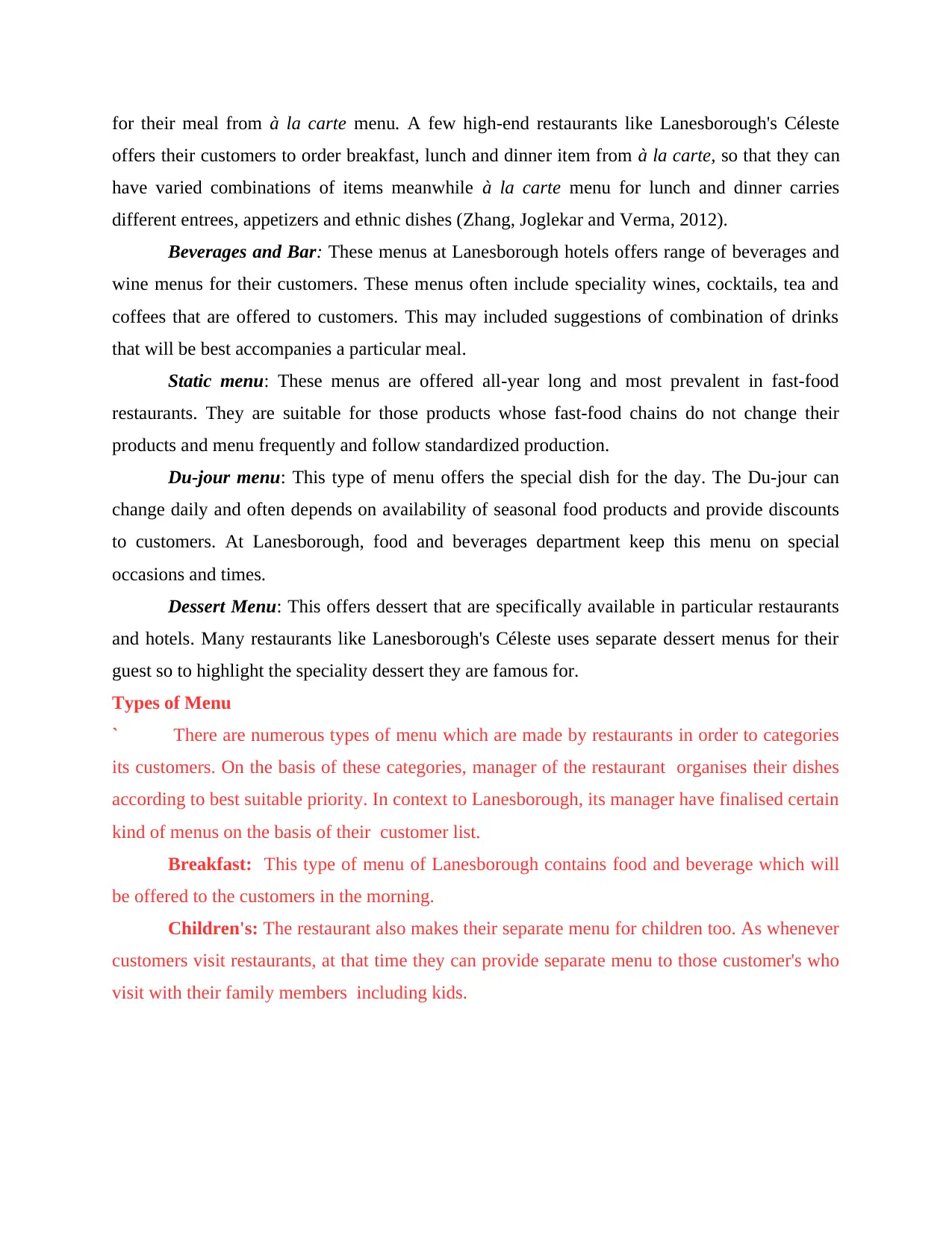
for their meal from à la carte menu. A few high-end restaurants like Lanesborough's Céleste
offers their customers to order breakfast, lunch and dinner item from à la carte, so that they can
have varied combinations of items meanwhile à la carte menu for lunch and dinner carries
different entrees, appetizers and ethnic dishes (Zhang, Joglekar and Verma, 2012).
Beverages and Bar: These menus at Lanesborough hotels offers range of beverages and
wine menus for their customers. These menus often include speciality wines, cocktails, tea and
coffees that are offered to customers. This may included suggestions of combination of drinks
that will be best accompanies a particular meal.
Static menu: These menus are offered all-year long and most prevalent in fast-food
restaurants. They are suitable for those products whose fast-food chains do not change their
products and menu frequently and follow standardized production.
Du-jour menu: This type of menu offers the special dish for the day. The Du-jour can
change daily and often depends on availability of seasonal food products and provide discounts
to customers. At Lanesborough, food and beverages department keep this menu on special
occasions and times.
Dessert Menu: This offers dessert that are specifically available in particular restaurants
and hotels. Many restaurants like Lanesborough's Céleste uses separate dessert menus for their
guest so to highlight the speciality dessert they are famous for.
Types of Menu
` There are numerous types of menu which are made by restaurants in order to categories
its customers. On the basis of these categories, manager of the restaurant organises their dishes
according to best suitable priority. In context to Lanesborough, its manager have finalised certain
kind of menus on the basis of their customer list.
Breakfast: This type of menu of Lanesborough contains food and beverage which will
be offered to the customers in the morning.
Children's: The restaurant also makes their separate menu for children too. As whenever
customers visit restaurants, at that time they can provide separate menu to those customer's who
visit with their family members including kids.
offers their customers to order breakfast, lunch and dinner item from à la carte, so that they can
have varied combinations of items meanwhile à la carte menu for lunch and dinner carries
different entrees, appetizers and ethnic dishes (Zhang, Joglekar and Verma, 2012).
Beverages and Bar: These menus at Lanesborough hotels offers range of beverages and
wine menus for their customers. These menus often include speciality wines, cocktails, tea and
coffees that are offered to customers. This may included suggestions of combination of drinks
that will be best accompanies a particular meal.
Static menu: These menus are offered all-year long and most prevalent in fast-food
restaurants. They are suitable for those products whose fast-food chains do not change their
products and menu frequently and follow standardized production.
Du-jour menu: This type of menu offers the special dish for the day. The Du-jour can
change daily and often depends on availability of seasonal food products and provide discounts
to customers. At Lanesborough, food and beverages department keep this menu on special
occasions and times.
Dessert Menu: This offers dessert that are specifically available in particular restaurants
and hotels. Many restaurants like Lanesborough's Céleste uses separate dessert menus for their
guest so to highlight the speciality dessert they are famous for.
Types of Menu
` There are numerous types of menu which are made by restaurants in order to categories
its customers. On the basis of these categories, manager of the restaurant organises their dishes
according to best suitable priority. In context to Lanesborough, its manager have finalised certain
kind of menus on the basis of their customer list.
Breakfast: This type of menu of Lanesborough contains food and beverage which will
be offered to the customers in the morning.
Children's: The restaurant also makes their separate menu for children too. As whenever
customers visit restaurants, at that time they can provide separate menu to those customer's who
visit with their family members including kids.
Secure Best Marks with AI Grader
Need help grading? Try our AI Grader for instant feedback on your assignments.
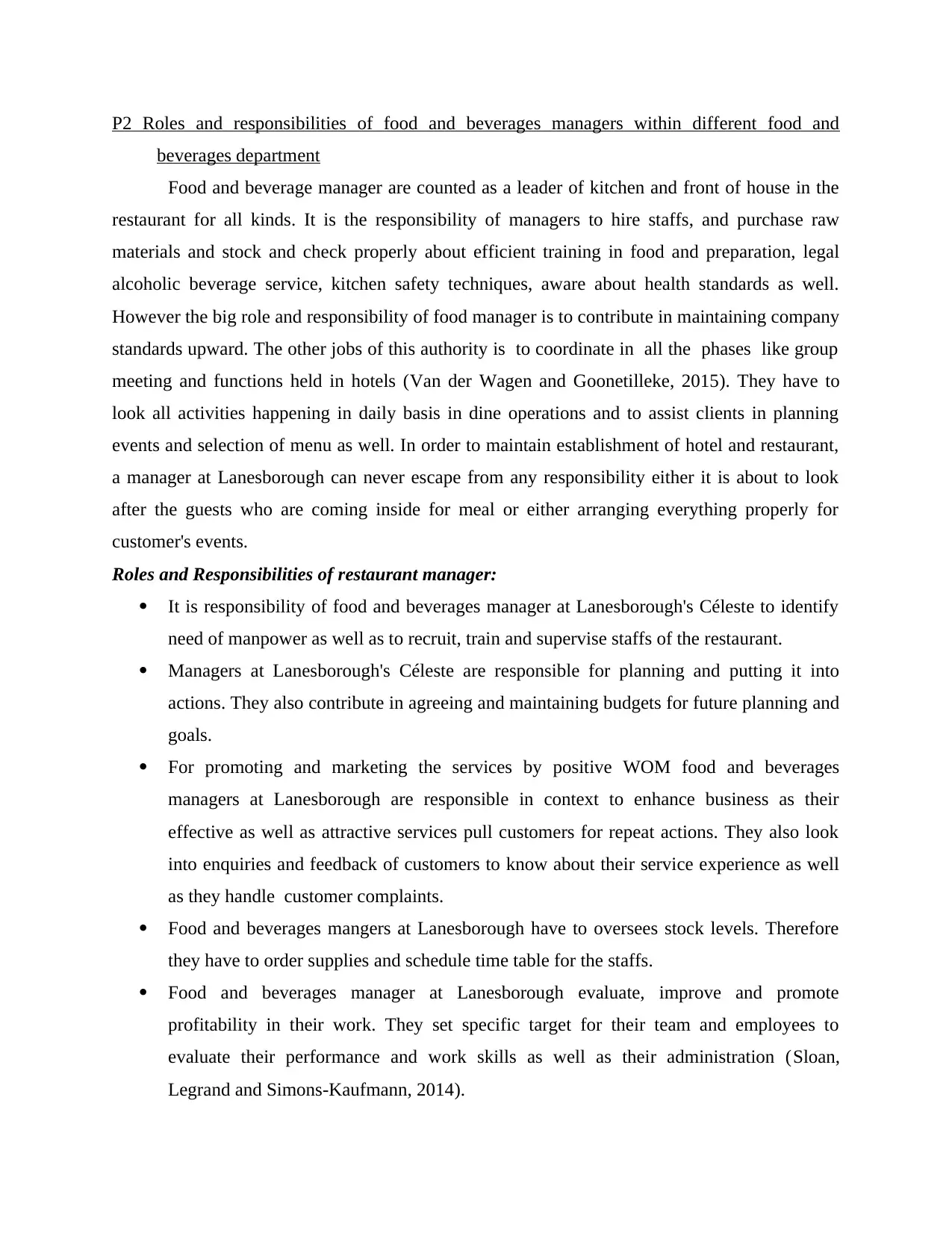
P2 Roles and responsibilities of food and beverages managers within different food and
beverages department
Food and beverage manager are counted as a leader of kitchen and front of house in the
restaurant for all kinds. It is the responsibility of managers to hire staffs, and purchase raw
materials and stock and check properly about efficient training in food and preparation, legal
alcoholic beverage service, kitchen safety techniques, aware about health standards as well.
However the big role and responsibility of food manager is to contribute in maintaining company
standards upward. The other jobs of this authority is to coordinate in all the phases like group
meeting and functions held in hotels (Van der Wagen and Goonetilleke, 2015). They have to
look all activities happening in daily basis in dine operations and to assist clients in planning
events and selection of menu as well. In order to maintain establishment of hotel and restaurant,
a manager at Lanesborough can never escape from any responsibility either it is about to look
after the guests who are coming inside for meal or either arranging everything properly for
customer's events.
Roles and Responsibilities of restaurant manager:
It is responsibility of food and beverages manager at Lanesborough's Céleste to identify
need of manpower as well as to recruit, train and supervise staffs of the restaurant.
Managers at Lanesborough's Céleste are responsible for planning and putting it into
actions. They also contribute in agreeing and maintaining budgets for future planning and
goals.
For promoting and marketing the services by positive WOM food and beverages
managers at Lanesborough are responsible in context to enhance business as their
effective as well as attractive services pull customers for repeat actions. They also look
into enquiries and feedback of customers to know about their service experience as well
as they handle customer complaints.
Food and beverages mangers at Lanesborough have to oversees stock levels. Therefore
they have to order supplies and schedule time table for the staffs.
Food and beverages manager at Lanesborough evaluate, improve and promote
profitability in their work. They set specific target for their team and employees to
evaluate their performance and work skills as well as their administration (Sloan,
Legrand and Simons-Kaufmann, 2014).
beverages department
Food and beverage manager are counted as a leader of kitchen and front of house in the
restaurant for all kinds. It is the responsibility of managers to hire staffs, and purchase raw
materials and stock and check properly about efficient training in food and preparation, legal
alcoholic beverage service, kitchen safety techniques, aware about health standards as well.
However the big role and responsibility of food manager is to contribute in maintaining company
standards upward. The other jobs of this authority is to coordinate in all the phases like group
meeting and functions held in hotels (Van der Wagen and Goonetilleke, 2015). They have to
look all activities happening in daily basis in dine operations and to assist clients in planning
events and selection of menu as well. In order to maintain establishment of hotel and restaurant,
a manager at Lanesborough can never escape from any responsibility either it is about to look
after the guests who are coming inside for meal or either arranging everything properly for
customer's events.
Roles and Responsibilities of restaurant manager:
It is responsibility of food and beverages manager at Lanesborough's Céleste to identify
need of manpower as well as to recruit, train and supervise staffs of the restaurant.
Managers at Lanesborough's Céleste are responsible for planning and putting it into
actions. They also contribute in agreeing and maintaining budgets for future planning and
goals.
For promoting and marketing the services by positive WOM food and beverages
managers at Lanesborough are responsible in context to enhance business as their
effective as well as attractive services pull customers for repeat actions. They also look
into enquiries and feedback of customers to know about their service experience as well
as they handle customer complaints.
Food and beverages mangers at Lanesborough have to oversees stock levels. Therefore
they have to order supplies and schedule time table for the staffs.
Food and beverages manager at Lanesborough evaluate, improve and promote
profitability in their work. They set specific target for their team and employees to
evaluate their performance and work skills as well as their administration (Sloan,
Legrand and Simons-Kaufmann, 2014).
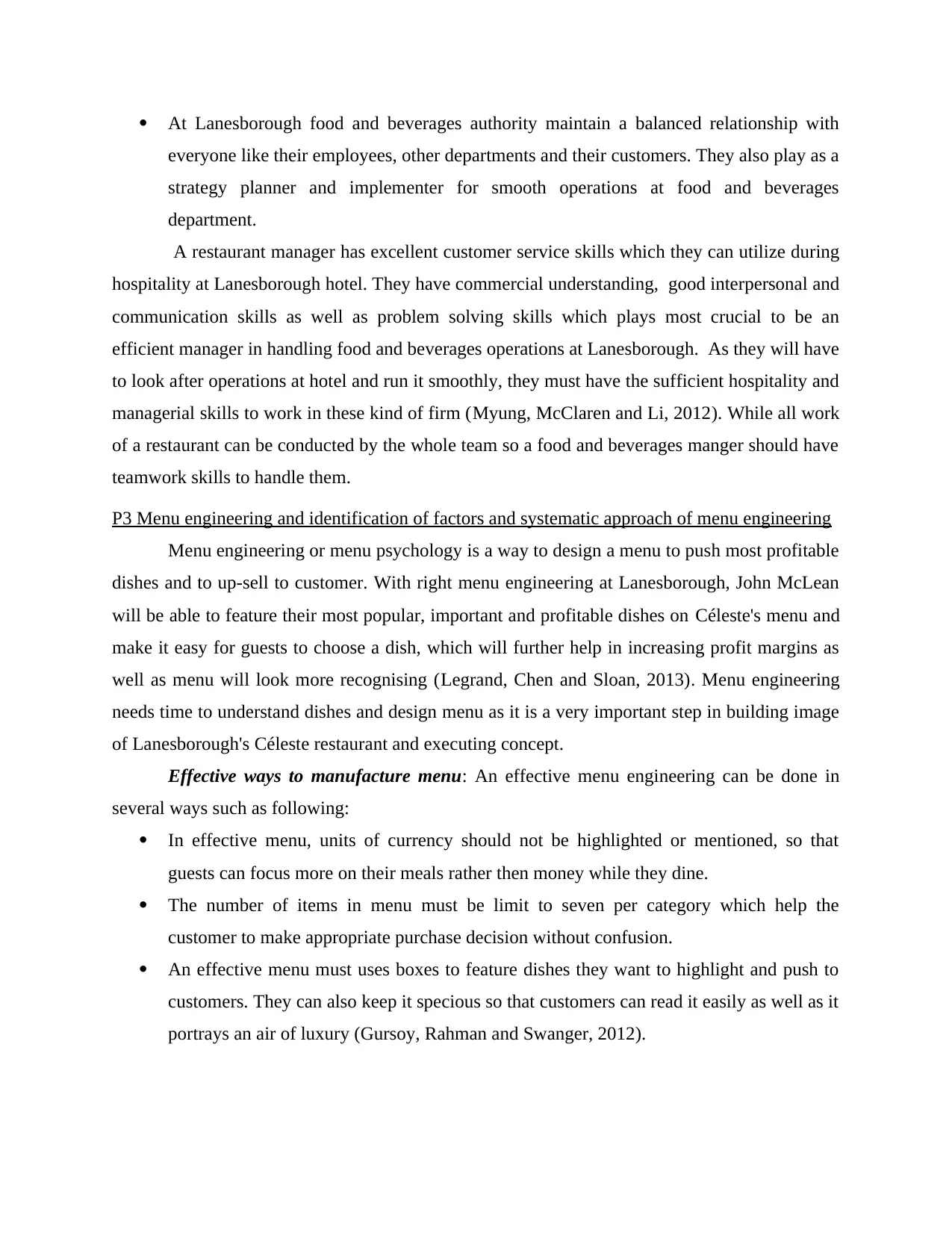
At Lanesborough food and beverages authority maintain a balanced relationship with
everyone like their employees, other departments and their customers. They also play as a
strategy planner and implementer for smooth operations at food and beverages
department.
A restaurant manager has excellent customer service skills which they can utilize during
hospitality at Lanesborough hotel. They have commercial understanding, good interpersonal and
communication skills as well as problem solving skills which plays most crucial to be an
efficient manager in handling food and beverages operations at Lanesborough. As they will have
to look after operations at hotel and run it smoothly, they must have the sufficient hospitality and
managerial skills to work in these kind of firm (Myung, McClaren and Li, 2012). While all work
of a restaurant can be conducted by the whole team so a food and beverages manger should have
teamwork skills to handle them.
P3 Menu engineering and identification of factors and systematic approach of menu engineering
Menu engineering or menu psychology is a way to design a menu to push most profitable
dishes and to up-sell to customer. With right menu engineering at Lanesborough, John McLean
will be able to feature their most popular, important and profitable dishes on Céleste's menu and
make it easy for guests to choose a dish, which will further help in increasing profit margins as
well as menu will look more recognising (Legrand, Chen and Sloan, 2013). Menu engineering
needs time to understand dishes and design menu as it is a very important step in building image
of Lanesborough's Céleste restaurant and executing concept.
Effective ways to manufacture menu: An effective menu engineering can be done in
several ways such as following:
In effective menu, units of currency should not be highlighted or mentioned, so that
guests can focus more on their meals rather then money while they dine.
The number of items in menu must be limit to seven per category which help the
customer to make appropriate purchase decision without confusion.
An effective menu must uses boxes to feature dishes they want to highlight and push to
customers. They can also keep it specious so that customers can read it easily as well as it
portrays an air of luxury (Gursoy, Rahman and Swanger, 2012).
everyone like their employees, other departments and their customers. They also play as a
strategy planner and implementer for smooth operations at food and beverages
department.
A restaurant manager has excellent customer service skills which they can utilize during
hospitality at Lanesborough hotel. They have commercial understanding, good interpersonal and
communication skills as well as problem solving skills which plays most crucial to be an
efficient manager in handling food and beverages operations at Lanesborough. As they will have
to look after operations at hotel and run it smoothly, they must have the sufficient hospitality and
managerial skills to work in these kind of firm (Myung, McClaren and Li, 2012). While all work
of a restaurant can be conducted by the whole team so a food and beverages manger should have
teamwork skills to handle them.
P3 Menu engineering and identification of factors and systematic approach of menu engineering
Menu engineering or menu psychology is a way to design a menu to push most profitable
dishes and to up-sell to customer. With right menu engineering at Lanesborough, John McLean
will be able to feature their most popular, important and profitable dishes on Céleste's menu and
make it easy for guests to choose a dish, which will further help in increasing profit margins as
well as menu will look more recognising (Legrand, Chen and Sloan, 2013). Menu engineering
needs time to understand dishes and design menu as it is a very important step in building image
of Lanesborough's Céleste restaurant and executing concept.
Effective ways to manufacture menu: An effective menu engineering can be done in
several ways such as following:
In effective menu, units of currency should not be highlighted or mentioned, so that
guests can focus more on their meals rather then money while they dine.
The number of items in menu must be limit to seven per category which help the
customer to make appropriate purchase decision without confusion.
An effective menu must uses boxes to feature dishes they want to highlight and push to
customers. They can also keep it specious so that customers can read it easily as well as it
portrays an air of luxury (Gursoy, Rahman and Swanger, 2012).
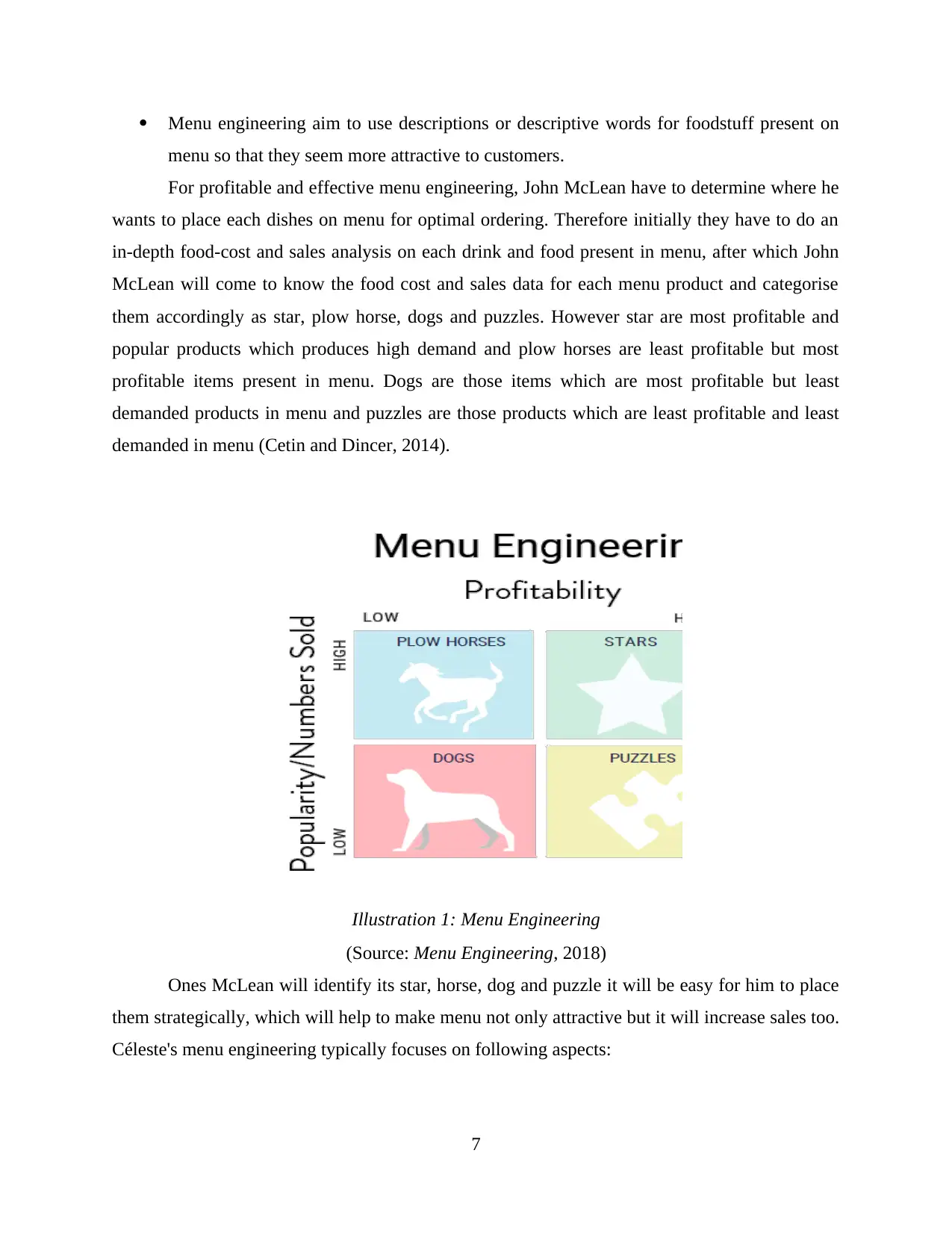
Menu engineering aim to use descriptions or descriptive words for foodstuff present on
menu so that they seem more attractive to customers.
For profitable and effective menu engineering, John McLean have to determine where he
wants to place each dishes on menu for optimal ordering. Therefore initially they have to do an
in-depth food-cost and sales analysis on each drink and food present in menu, after which John
McLean will come to know the food cost and sales data for each menu product and categorise
them accordingly as star, plow horse, dogs and puzzles. However star are most profitable and
popular products which produces high demand and plow horses are least profitable but most
profitable items present in menu. Dogs are those items which are most profitable but least
demanded products in menu and puzzles are those products which are least profitable and least
demanded in menu (Cetin and Dincer, 2014).
(Source: Menu Engineering, 2018)
Ones McLean will identify its star, horse, dog and puzzle it will be easy for him to place
them strategically, which will help to make menu not only attractive but it will increase sales too.
Céleste's menu engineering typically focuses on following aspects:
7
Illustration 1: Menu Engineering
menu so that they seem more attractive to customers.
For profitable and effective menu engineering, John McLean have to determine where he
wants to place each dishes on menu for optimal ordering. Therefore initially they have to do an
in-depth food-cost and sales analysis on each drink and food present in menu, after which John
McLean will come to know the food cost and sales data for each menu product and categorise
them accordingly as star, plow horse, dogs and puzzles. However star are most profitable and
popular products which produces high demand and plow horses are least profitable but most
profitable items present in menu. Dogs are those items which are most profitable but least
demanded products in menu and puzzles are those products which are least profitable and least
demanded in menu (Cetin and Dincer, 2014).
(Source: Menu Engineering, 2018)
Ones McLean will identify its star, horse, dog and puzzle it will be easy for him to place
them strategically, which will help to make menu not only attractive but it will increase sales too.
Céleste's menu engineering typically focuses on following aspects:
7
Illustration 1: Menu Engineering
Paraphrase This Document
Need a fresh take? Get an instant paraphrase of this document with our AI Paraphraser
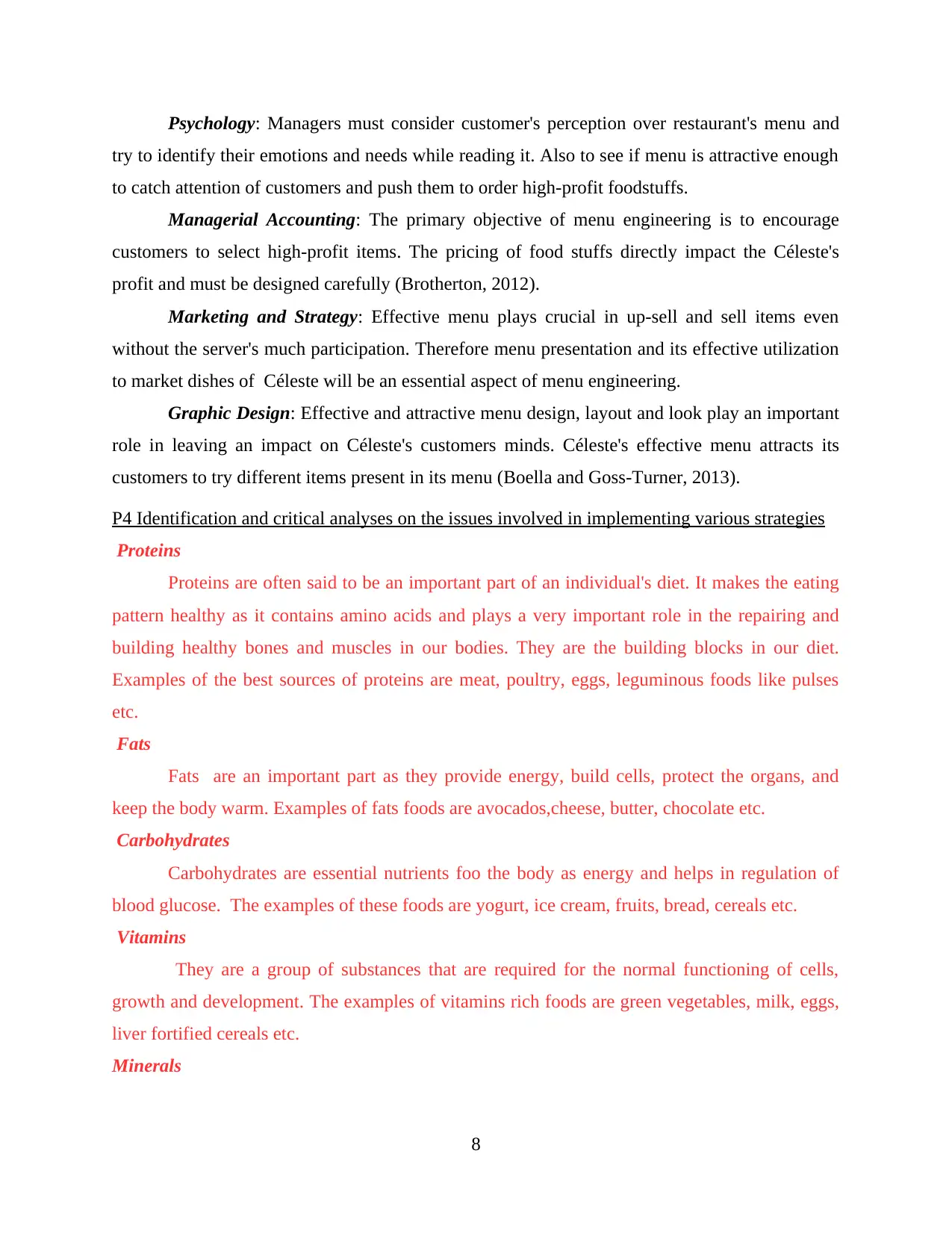
Psychology: Managers must consider customer's perception over restaurant's menu and
try to identify their emotions and needs while reading it. Also to see if menu is attractive enough
to catch attention of customers and push them to order high-profit foodstuffs.
Managerial Accounting: The primary objective of menu engineering is to encourage
customers to select high-profit items. The pricing of food stuffs directly impact the Céleste's
profit and must be designed carefully (Brotherton, 2012).
Marketing and Strategy: Effective menu plays crucial in up-sell and sell items even
without the server's much participation. Therefore menu presentation and its effective utilization
to market dishes of Céleste will be an essential aspect of menu engineering.
Graphic Design: Effective and attractive menu design, layout and look play an important
role in leaving an impact on Céleste's customers minds. Céleste's effective menu attracts its
customers to try different items present in its menu (Boella and Goss-Turner, 2013).
P4 Identification and critical analyses on the issues involved in implementing various strategies
Proteins
Proteins are often said to be an important part of an individual's diet. It makes the eating
pattern healthy as it contains amino acids and plays a very important role in the repairing and
building healthy bones and muscles in our bodies. They are the building blocks in our diet.
Examples of the best sources of proteins are meat, poultry, eggs, leguminous foods like pulses
etc.
Fats
Fats are an important part as they provide energy, build cells, protect the organs, and
keep the body warm. Examples of fats foods are avocados,cheese, butter, chocolate etc.
Carbohydrates
Carbohydrates are essential nutrients foo the body as energy and helps in regulation of
blood glucose. The examples of these foods are yogurt, ice cream, fruits, bread, cereals etc.
Vitamins
They are a group of substances that are required for the normal functioning of cells,
growth and development. The examples of vitamins rich foods are green vegetables, milk, eggs,
liver fortified cereals etc.
Minerals
8
try to identify their emotions and needs while reading it. Also to see if menu is attractive enough
to catch attention of customers and push them to order high-profit foodstuffs.
Managerial Accounting: The primary objective of menu engineering is to encourage
customers to select high-profit items. The pricing of food stuffs directly impact the Céleste's
profit and must be designed carefully (Brotherton, 2012).
Marketing and Strategy: Effective menu plays crucial in up-sell and sell items even
without the server's much participation. Therefore menu presentation and its effective utilization
to market dishes of Céleste will be an essential aspect of menu engineering.
Graphic Design: Effective and attractive menu design, layout and look play an important
role in leaving an impact on Céleste's customers minds. Céleste's effective menu attracts its
customers to try different items present in its menu (Boella and Goss-Turner, 2013).
P4 Identification and critical analyses on the issues involved in implementing various strategies
Proteins
Proteins are often said to be an important part of an individual's diet. It makes the eating
pattern healthy as it contains amino acids and plays a very important role in the repairing and
building healthy bones and muscles in our bodies. They are the building blocks in our diet.
Examples of the best sources of proteins are meat, poultry, eggs, leguminous foods like pulses
etc.
Fats
Fats are an important part as they provide energy, build cells, protect the organs, and
keep the body warm. Examples of fats foods are avocados,cheese, butter, chocolate etc.
Carbohydrates
Carbohydrates are essential nutrients foo the body as energy and helps in regulation of
blood glucose. The examples of these foods are yogurt, ice cream, fruits, bread, cereals etc.
Vitamins
They are a group of substances that are required for the normal functioning of cells,
growth and development. The examples of vitamins rich foods are green vegetables, milk, eggs,
liver fortified cereals etc.
Minerals
8
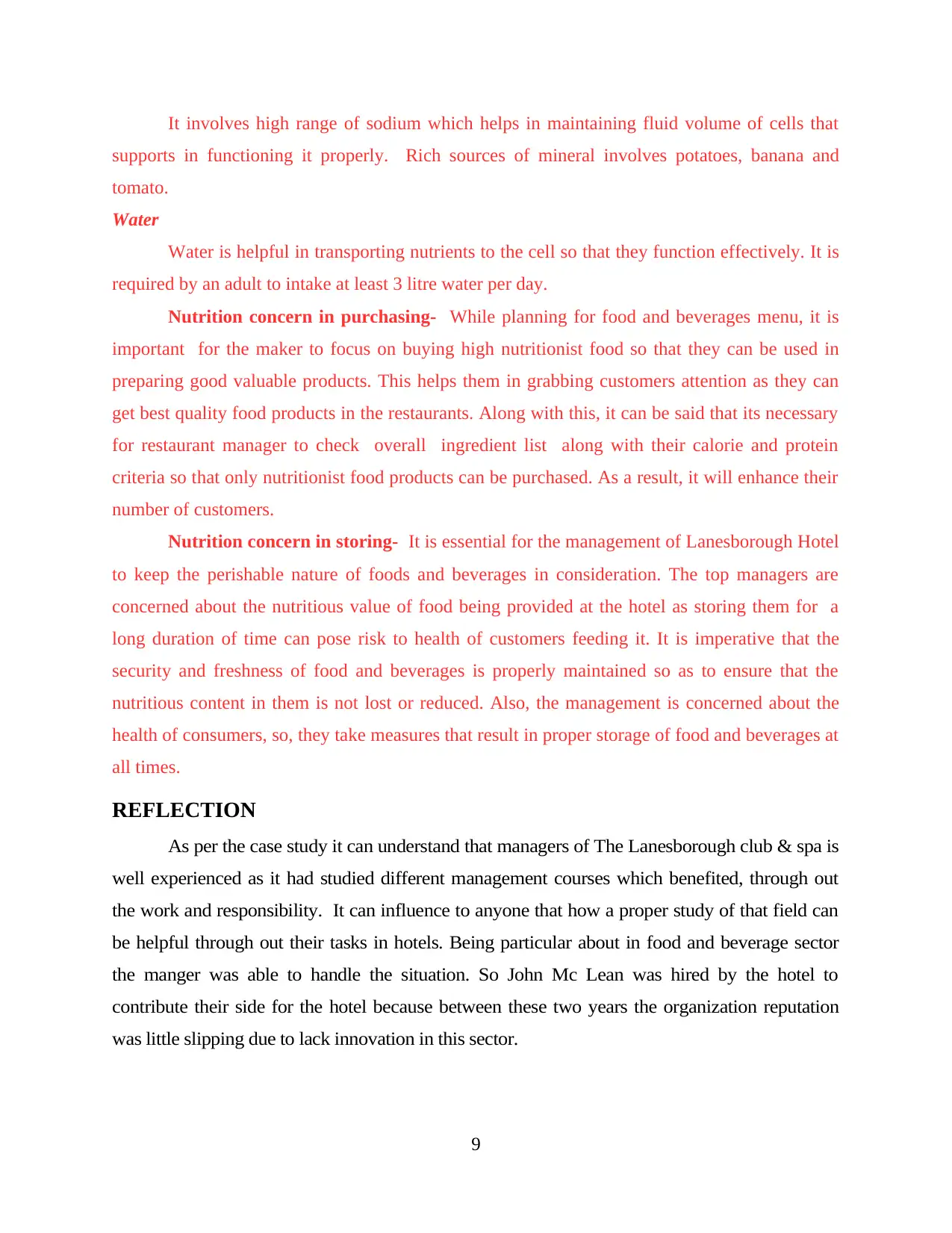
It involves high range of sodium which helps in maintaining fluid volume of cells that
supports in functioning it properly. Rich sources of mineral involves potatoes, banana and
tomato.
Water
Water is helpful in transporting nutrients to the cell so that they function effectively. It is
required by an adult to intake at least 3 litre water per day.
Nutrition concern in purchasing- While planning for food and beverages menu, it is
important for the maker to focus on buying high nutritionist food so that they can be used in
preparing good valuable products. This helps them in grabbing customers attention as they can
get best quality food products in the restaurants. Along with this, it can be said that its necessary
for restaurant manager to check overall ingredient list along with their calorie and protein
criteria so that only nutritionist food products can be purchased. As a result, it will enhance their
number of customers.
Nutrition concern in storing- It is essential for the management of Lanesborough Hotel
to keep the perishable nature of foods and beverages in consideration. The top managers are
concerned about the nutritious value of food being provided at the hotel as storing them for a
long duration of time can pose risk to health of customers feeding it. It is imperative that the
security and freshness of food and beverages is properly maintained so as to ensure that the
nutritious content in them is not lost or reduced. Also, the management is concerned about the
health of consumers, so, they take measures that result in proper storage of food and beverages at
all times.
REFLECTION
As per the case study it can understand that managers of The Lanesborough club & spa is
well experienced as it had studied different management courses which benefited, through out
the work and responsibility. It can influence to anyone that how a proper study of that field can
be helpful through out their tasks in hotels. Being particular about in food and beverage sector
the manger was able to handle the situation. So John Mc Lean was hired by the hotel to
contribute their side for the hotel because between these two years the organization reputation
was little slipping due to lack innovation in this sector.
9
supports in functioning it properly. Rich sources of mineral involves potatoes, banana and
tomato.
Water
Water is helpful in transporting nutrients to the cell so that they function effectively. It is
required by an adult to intake at least 3 litre water per day.
Nutrition concern in purchasing- While planning for food and beverages menu, it is
important for the maker to focus on buying high nutritionist food so that they can be used in
preparing good valuable products. This helps them in grabbing customers attention as they can
get best quality food products in the restaurants. Along with this, it can be said that its necessary
for restaurant manager to check overall ingredient list along with their calorie and protein
criteria so that only nutritionist food products can be purchased. As a result, it will enhance their
number of customers.
Nutrition concern in storing- It is essential for the management of Lanesborough Hotel
to keep the perishable nature of foods and beverages in consideration. The top managers are
concerned about the nutritious value of food being provided at the hotel as storing them for a
long duration of time can pose risk to health of customers feeding it. It is imperative that the
security and freshness of food and beverages is properly maintained so as to ensure that the
nutritious content in them is not lost or reduced. Also, the management is concerned about the
health of consumers, so, they take measures that result in proper storage of food and beverages at
all times.
REFLECTION
As per the case study it can understand that managers of The Lanesborough club & spa is
well experienced as it had studied different management courses which benefited, through out
the work and responsibility. It can influence to anyone that how a proper study of that field can
be helpful through out their tasks in hotels. Being particular about in food and beverage sector
the manger was able to handle the situation. So John Mc Lean was hired by the hotel to
contribute their side for the hotel because between these two years the organization reputation
was little slipping due to lack innovation in this sector.
9
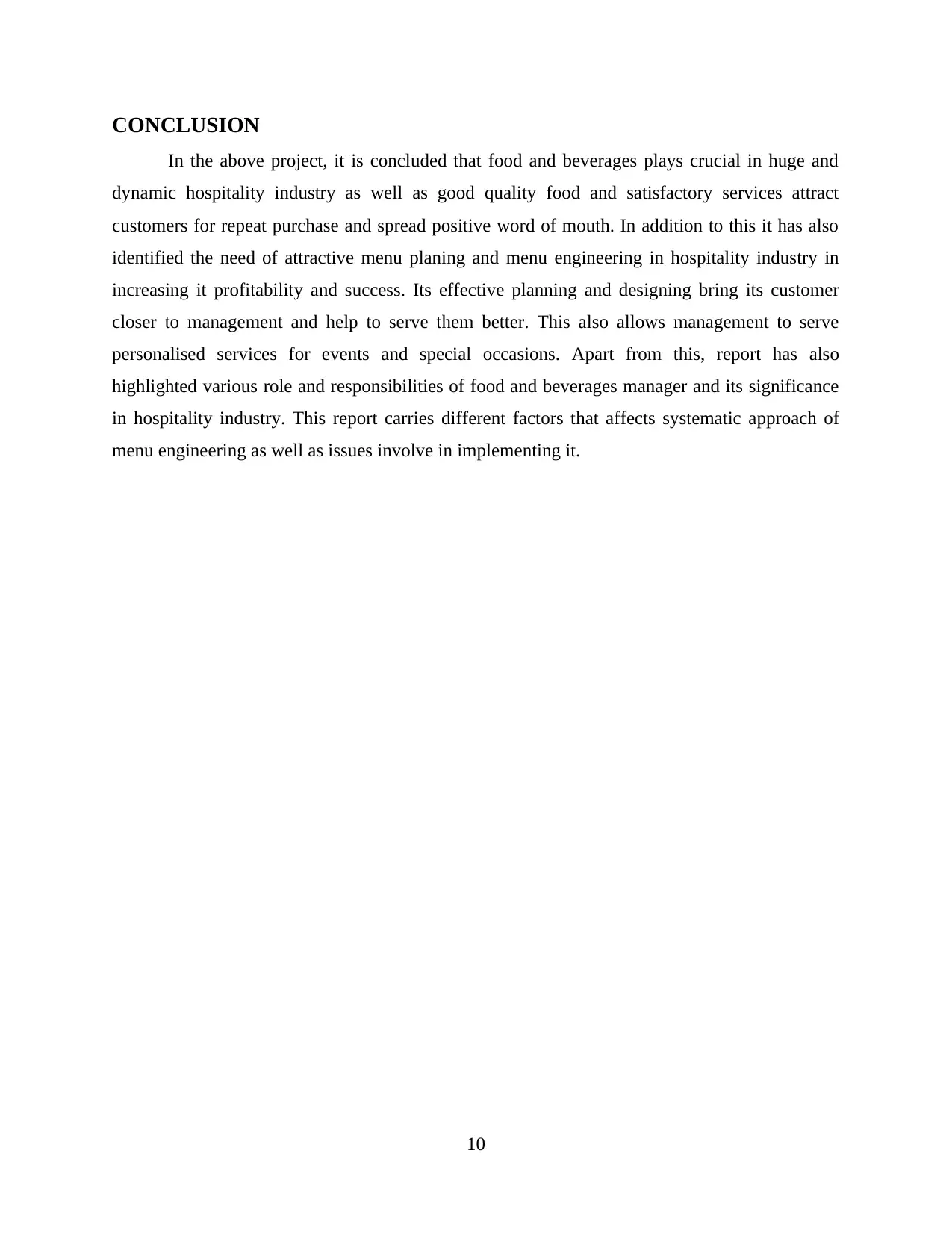
CONCLUSION
In the above project, it is concluded that food and beverages plays crucial in huge and
dynamic hospitality industry as well as good quality food and satisfactory services attract
customers for repeat purchase and spread positive word of mouth. In addition to this it has also
identified the need of attractive menu planing and menu engineering in hospitality industry in
increasing it profitability and success. Its effective planning and designing bring its customer
closer to management and help to serve them better. This also allows management to serve
personalised services for events and special occasions. Apart from this, report has also
highlighted various role and responsibilities of food and beverages manager and its significance
in hospitality industry. This report carries different factors that affects systematic approach of
menu engineering as well as issues involve in implementing it.
10
In the above project, it is concluded that food and beverages plays crucial in huge and
dynamic hospitality industry as well as good quality food and satisfactory services attract
customers for repeat purchase and spread positive word of mouth. In addition to this it has also
identified the need of attractive menu planing and menu engineering in hospitality industry in
increasing it profitability and success. Its effective planning and designing bring its customer
closer to management and help to serve them better. This also allows management to serve
personalised services for events and special occasions. Apart from this, report has also
highlighted various role and responsibilities of food and beverages manager and its significance
in hospitality industry. This report carries different factors that affects systematic approach of
menu engineering as well as issues involve in implementing it.
10
Secure Best Marks with AI Grader
Need help grading? Try our AI Grader for instant feedback on your assignments.
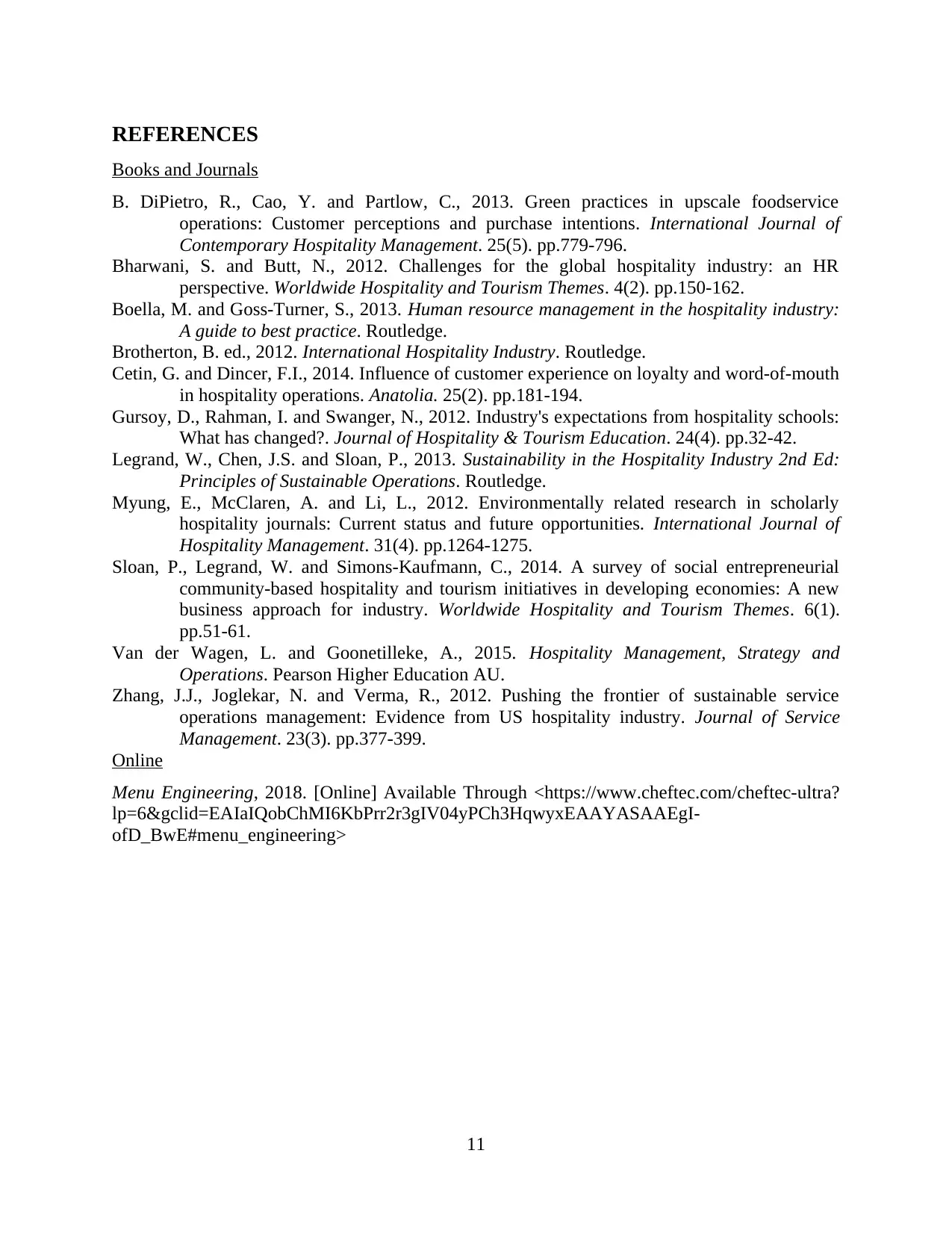
REFERENCES
Books and Journals
B. DiPietro, R., Cao, Y. and Partlow, C., 2013. Green practices in upscale foodservice
operations: Customer perceptions and purchase intentions. International Journal of
Contemporary Hospitality Management. 25(5). pp.779-796.
Bharwani, S. and Butt, N., 2012. Challenges for the global hospitality industry: an HR
perspective. Worldwide Hospitality and Tourism Themes. 4(2). pp.150-162.
Boella, M. and Goss-Turner, S., 2013. Human resource management in the hospitality industry:
A guide to best practice. Routledge.
Brotherton, B. ed., 2012. International Hospitality Industry. Routledge.
Cetin, G. and Dincer, F.I., 2014. Influence of customer experience on loyalty and word-of-mouth
in hospitality operations. Anatolia. 25(2). pp.181-194.
Gursoy, D., Rahman, I. and Swanger, N., 2012. Industry's expectations from hospitality schools:
What has changed?. Journal of Hospitality & Tourism Education. 24(4). pp.32-42.
Legrand, W., Chen, J.S. and Sloan, P., 2013. Sustainability in the Hospitality Industry 2nd Ed:
Principles of Sustainable Operations. Routledge.
Myung, E., McClaren, A. and Li, L., 2012. Environmentally related research in scholarly
hospitality journals: Current status and future opportunities. International Journal of
Hospitality Management. 31(4). pp.1264-1275.
Sloan, P., Legrand, W. and Simons-Kaufmann, C., 2014. A survey of social entrepreneurial
community-based hospitality and tourism initiatives in developing economies: A new
business approach for industry. Worldwide Hospitality and Tourism Themes. 6(1).
pp.51-61.
Van der Wagen, L. and Goonetilleke, A., 2015. Hospitality Management, Strategy and
Operations. Pearson Higher Education AU.
Zhang, J.J., Joglekar, N. and Verma, R., 2012. Pushing the frontier of sustainable service
operations management: Evidence from US hospitality industry. Journal of Service
Management. 23(3). pp.377-399.
Online
Menu Engineering, 2018. [Online] Available Through <https://www.cheftec.com/cheftec-ultra?
lp=6&gclid=EAIaIQobChMI6KbPrr2r3gIV04yPCh3HqwyxEAAYASAAEgI-
ofD_BwE#menu_engineering>
11
Books and Journals
B. DiPietro, R., Cao, Y. and Partlow, C., 2013. Green practices in upscale foodservice
operations: Customer perceptions and purchase intentions. International Journal of
Contemporary Hospitality Management. 25(5). pp.779-796.
Bharwani, S. and Butt, N., 2012. Challenges for the global hospitality industry: an HR
perspective. Worldwide Hospitality and Tourism Themes. 4(2). pp.150-162.
Boella, M. and Goss-Turner, S., 2013. Human resource management in the hospitality industry:
A guide to best practice. Routledge.
Brotherton, B. ed., 2012. International Hospitality Industry. Routledge.
Cetin, G. and Dincer, F.I., 2014. Influence of customer experience on loyalty and word-of-mouth
in hospitality operations. Anatolia. 25(2). pp.181-194.
Gursoy, D., Rahman, I. and Swanger, N., 2012. Industry's expectations from hospitality schools:
What has changed?. Journal of Hospitality & Tourism Education. 24(4). pp.32-42.
Legrand, W., Chen, J.S. and Sloan, P., 2013. Sustainability in the Hospitality Industry 2nd Ed:
Principles of Sustainable Operations. Routledge.
Myung, E., McClaren, A. and Li, L., 2012. Environmentally related research in scholarly
hospitality journals: Current status and future opportunities. International Journal of
Hospitality Management. 31(4). pp.1264-1275.
Sloan, P., Legrand, W. and Simons-Kaufmann, C., 2014. A survey of social entrepreneurial
community-based hospitality and tourism initiatives in developing economies: A new
business approach for industry. Worldwide Hospitality and Tourism Themes. 6(1).
pp.51-61.
Van der Wagen, L. and Goonetilleke, A., 2015. Hospitality Management, Strategy and
Operations. Pearson Higher Education AU.
Zhang, J.J., Joglekar, N. and Verma, R., 2012. Pushing the frontier of sustainable service
operations management: Evidence from US hospitality industry. Journal of Service
Management. 23(3). pp.377-399.
Online
Menu Engineering, 2018. [Online] Available Through <https://www.cheftec.com/cheftec-ultra?
lp=6&gclid=EAIaIQobChMI6KbPrr2r3gIV04yPCh3HqwyxEAAYASAAEgI-
ofD_BwE#menu_engineering>
11
1 out of 11
Related Documents
Your All-in-One AI-Powered Toolkit for Academic Success.
+13062052269
info@desklib.com
Available 24*7 on WhatsApp / Email
![[object Object]](/_next/static/media/star-bottom.7253800d.svg)
Unlock your academic potential
© 2024 | Zucol Services PVT LTD | All rights reserved.





